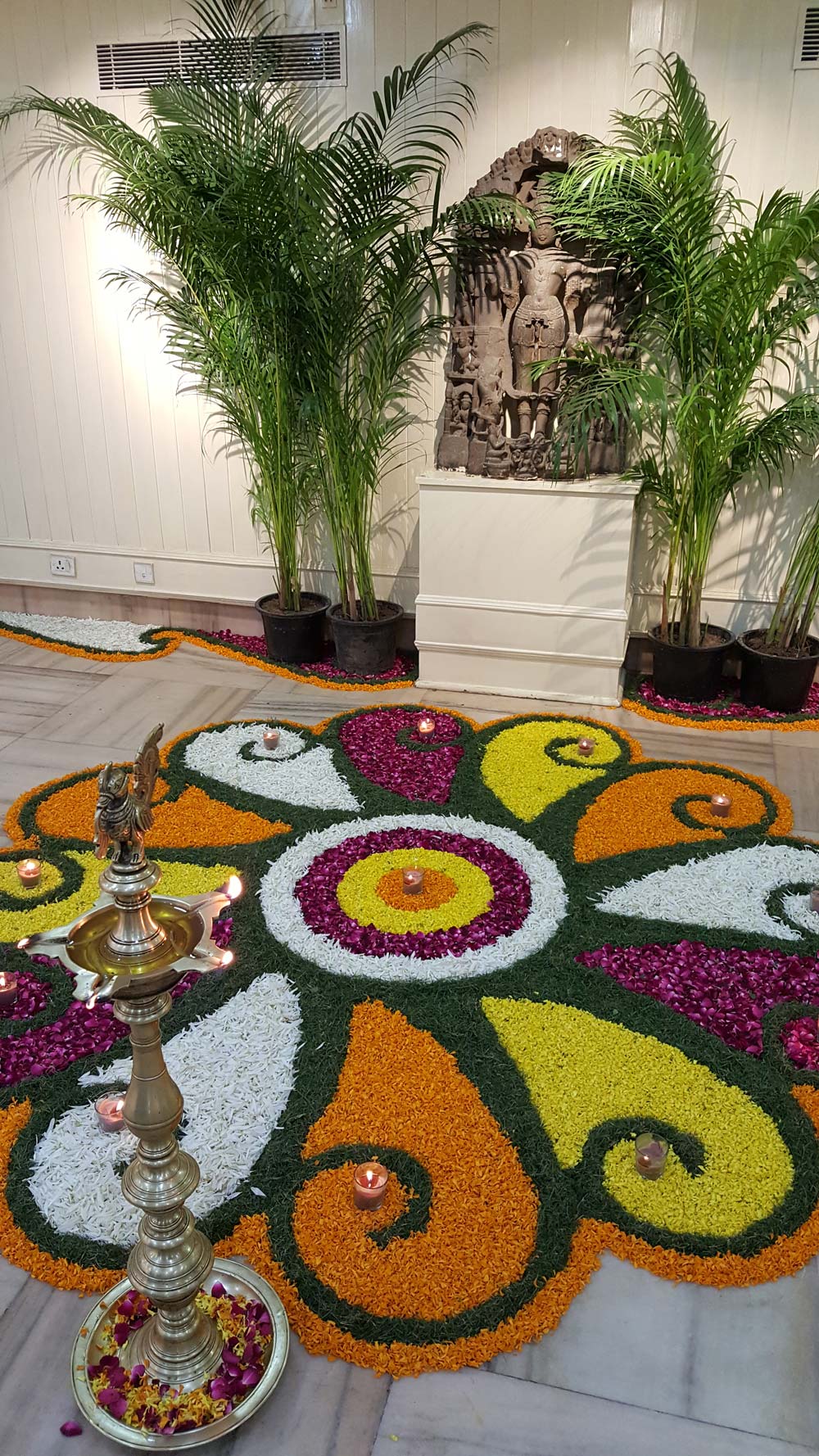
A rangoli decoration of flower petals and grass
welcomes visitors to performances at Kamani Auditorium.
1 Nov. New Delhi
My cold was better in the morning with just a minor sore
throat and sniffles. Although I could have visited more of Vrindavan’s temples,
it seemed better to just rest awhile, then head to New Delhi. I had a fine
Western breakfast—Indians are good at these—at the fancy hotel nearby, Hare
Krishna Orchid. When going down the apartment elevator with my host, the power
went out, but he pried open the doors with a key, then pulled them apart with
his hands so that we could get out. He gave me a ride on his motorbike back to
the main temple, where I got an electric autorickshaw to the bus stand, then a
shared autorickshaw to the train station in Matura. Here I purchased a 95-rupee
‘super-fast’ express ticket for New Delhi. This could be for any train in the
next three hours, but the trick was finding out which trains went there, then
get on and maybe find a seat. Eventually I got aboard a train and was lucky to
get a place to sit down in a three-tiered air-conditioned sleeper. This was
probably a higher class than my ticket was good for, but nobody asked to see the
ticket. The train was far, far smoother and cleaner than yesterday’s bus, but
took an extremely long time getting through the outskirts of New Delhi. Indian
trains encounter traffic jams too! I got off at New Delhi Railway Station and
walked down Parharganj’s chaotic Main Bazaar road. It looked much the same as on
my last visit two years ago, except that electric autorickshaws had made an
appearance. If you hate filth, then Paharganj wouldn’t be your kind of place,
but it does have heaps of good-value places to stay and eat. The New Delhi
Railway Station and a Metro station are conveniently at its eastern end and
another Metro station at the western end.
Of the world’s big cities, New
Delhi is a favorite of mine for the incredible amount and variety of cultural
programs and art galleries, while having a low cost of living. As the nation’s
capital, it has a more cosmopolitan feel than India’s other big metros. Most of
my 16 or so visits to India over the decades have passed through here. Air
pollution is the big downside, and the air tends to smell dusty. One would think
the leaders of India would clean up their showplace city, but that has yet to
happen. I will stay eight days, mainly to take in programs of Indian classical
dance and music plus visit some of the many art museums and exhibits.
International programs will likely be on offer as well.
I made an online
booking yesterday with Booking.com for Yes Please Guest House, which I assumed
to be the Cottage Yes Please near the west end of Paharganj’s Main Bazaar, but
the name is a bit of a scam and not the same place. This one is far more
basic—and cheaper at just 400 rupees—and near the middle of Main Bazaar.
On the other hand I didn’t have to make a deposit with the reservation and could
have simply moved elsewhere if I wished. My little single room lacked a window,
electrical outlet, or a shower (just Indian-style bucket bath), but did have a
marble floor! Staff rustled up a towel, top sheet, and chair.
One of the
things I really like about India is the huge selection of English newspapers and
magazines, and at a tiny fraction of what they would cost, in say, Thailand. My
reading started with The Times of India and the Indian versions of the magazines
Better Photography and Lonely Planet.
For dinner I had a good thali at
the vegetarian Festa Café
that’s located across the street from the real Cottage Yes Please. Also I
finally got around to buying a sim card for the phone by visiting the same tiny
shop I had used in 2013 and 2015. Getting set up required me to make a
verification call the next morning, then wait until things went through. Later I
bought an inexpensive international call plan that made overseas calls extremely
cheap. Indians love their mobile phones and think that anyone without one is a
bit strange!
2 Nov. New Delhi
All the rooms at Yes Please Guest House
open onto the halls, letting in lots of noise such as loud coughing from a room
across the hall during the night and loud talking and music early the next
morning. For a better place to stay I moved to nearby Ajay Guest House
https://www.ajayguesthouse.com/ where I had
come four years ago; a large room with hot water, a/c, marble floor, and little
bugs cost 900 rupees—not great but better than average in Parharganj. The
downstairs restaurant offers a 300-rupee buffet breakfast with cooked-to-order
eggs, porridge, juice, hot drink, fruit salad, and a selection of real breads
along with lots of spreads to put on the bread. All this filled me up so that I
could go until evening. Then back to Festa Café for a small pizza at the end of
the day.
3 Nov. New Delhi
Today I filled up on art and culture—my
main reason to visit New Delhi! With a Delhi Metro Rail travel card (saves
waiting in line to buy individual tokens), I rode three stops to Mandi House,
then took in the art exhibitions at the gallery in Lalit Kala Akademi
https://lalitkala.gov.in/ on the south
side of the big traffic circle. I enjoyed the shows—two group shows of paintings
and solo shows of paintings/sculptures, monochrome drawings of nature, and
photography—and got to meet a few of the artists.
Just about everybody
knows that the English composer Gustav Holst (1874-1934) wrote the orchestral
suite The Planets, but not that he had a “Sanskrit Phase” when he studied the
language in order to translate Hindu texts into English and set them to music.
He took a special interest in the Rig Veda, a set of more than 1000 hymns that
praise gods such as Varuna, Agni, and Indra plus the sacred plant soma. Tonight
at the India International Centre, The Bangalore Men along with a pianist
performed a selection of these. A European fellow conducted and was also a
skilled soloist for a couple songs. None of this was toe-tapping music, but
short piano pieces by Beethoven and Chopin and recitations of Kipling and Tagore
added variety.
I had a very spicy South Indian thali at a branch of
Saravana Bhavan
https://saravanabhavan.com/
on Janpath, close to the Janpath Metro station. Saravana Bhavan may be the
largest vegetarian restaurant chain in the world, and it was so popular tonight
that I had to wait awhile to get in. After the thali I cooled off with a
chocolate ice cream dessert.
4 Nov. New Delhi
Train travel is super
popular in India, so getting a seat or berth can be tough. I walked over to New
Delhi Railway Station to make a reservation for my next two destinations,
Lucknow and Allahabad. There’s a special booking office upstairs available only
to foreigners and can avail tickets from a “tourist quota.” Only two
people staffed the reservation desks for the crowd on hand, and it looked like a
long wait, so I thought of coming back tonight and try my luck. (The office is
open a lengthy 6 a.m. to 11 p.m.!)
Back at Mandy House traffic
circle, I turned north a bit on Tansen Marg to another art center, Triveni Kala
Sangam. Here two women offered very colorful and cheerful solo shows: Timeless
Mountains by West Bengal artist Sujata Kar Saha depicted landscapes, always
with a water element. Joie De Vivre: Celebrating Life by Paris-based Maya
Burman portrayed barefoot children playing in gardens.
A short Metro hop
to Central Secretariat led to AIFACS (All India Fine Arts & Crafts Society
Gallery) on Rafi Marg, where two galleries hosted Grains of Canvas, a large
group show of paintings and a few sculptures. Downstairs another pair of
galleries presented a photography and video exhibition including a selection of
short videos with themes as varied as a young Dutch boy learning to be a
wind-miller and a Chinese man encountering the end of the world. Nikon sponsored
the exhibition, and also had a display of its 35-millimeter film SLR cameras
from the 1959-vintage F1 to the last of the line, along with a couple versions
developed for use in outer space.
Then to Saravana Bhavan for more South
Indian tastes, this time a tomato uttapam and a pair of ravi idli followed, of
course, by an ice cream. Back at the train station, I managed to get the
desired train tickets without any waiting! That’s never happened to me before at
this booking office. Now I’m heading to Lucknow on the 9th, then on to Allahabad
three days later. Both trips go in the morning on fast trains with
air-conditioned ‘chair coach’ seating. The only disappointment was that foreign
seniors no longer get a discount!
5 Nov. New Delhi
I spent some
computer time to post texts of the India travels so far on my personal website.
The pages will look a lot better when photos—the next project—have been added. In the afternoon I headed to the cultural center India Habitat Centre
https://www.indiahabitat.org/ in a striking
cluster of giant cube-shaped buildings that form a series of courtyards. I first
wandered through two temporary art exhibitions of colorful paintings, the
dreamlike solo show Interpretation of Memories by Sumita Maity and the group
show of stylized portraits Different Strokes. A big photo exhibit illustrated
the endangered Aravalli Range that begins near New Delhi and extends southwest
across Haryana, Rajasthan, and Gujarat states. In the evening I listened to the
beautiful singing of Riddhi Bandopadhyay, a woman from Kolkata. She played the
harmonium and had a fellow on tabla (drums) and keyboard. Finally I swung by
Café Festa for a late and rich vegetable thali.
6 Nov. New Delhi
A
three-day Indian classical music and dance festival called Sangeet Samaroh began
this evening at the Kamani Auditorium
https://kamaniauditorium.org/ on Copernicus Road, a little south of the Mandi
House traffic circle. Music started with a Saraswathi veena concert by Dr.
Jayanthi Kumaresh, who masterfully played the complex instrument with its
distinctly Indian sound. Next Smt. (Indian honorific abbreviation for
‘Shrimati’) Bombay Jayashri Ramnath offered a Carnatic
(southern Indian) vocal recital, again with great skill, and accompanied by a
violinist who seemed to be having a ‘conversation’ with the singing. Nearly four
hours had passed by the time I left! This, like most cultural performances in
New Delhi, had free admission. Again, I had a late dinner of a thali at Café
Festa just before it closed.

A rangoli
decoration of flower petals and grass
welcomes visitors to performances at
Kamani Auditorium.
7 Dec. New Delhi
I started with a swing
through art exhibitions at the Japan Foundation, south of the center and
conveniently next to Moorchand Metro stop, to see artwork and videos about Nizo
Yamamoto who makes detailed background paintings for animation films. Then I
walked half a kilometer east to the Korean Cultural Center for a group show
Interfaces of Being, but didn’t like most of it.
I made a second
visit to India Habitat Centre, where the Aravalli Range exhibits included a
photography show that used four early photographic printing
techniques—cyanotype, anthotype, salt print, and gum bichromate—and a set of
videos taken from a drone. A new photography exhibition
had just opened that included memorable views of the Indian Himalaya and Ladakh.
I also took in a new show of colorful (Indians like color!) paintings.
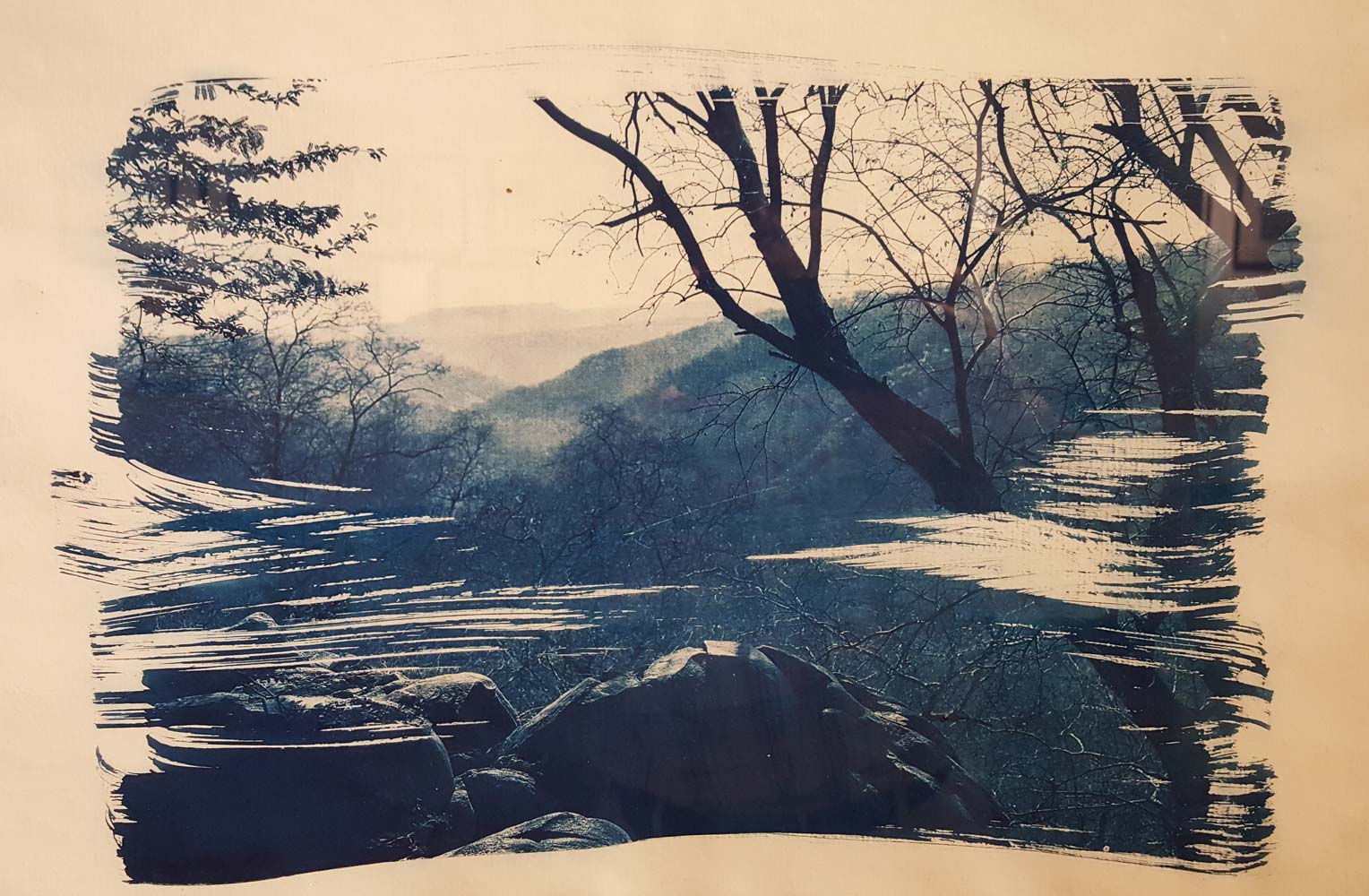
A cyanotype
print in the show Aravalli Deconstructed
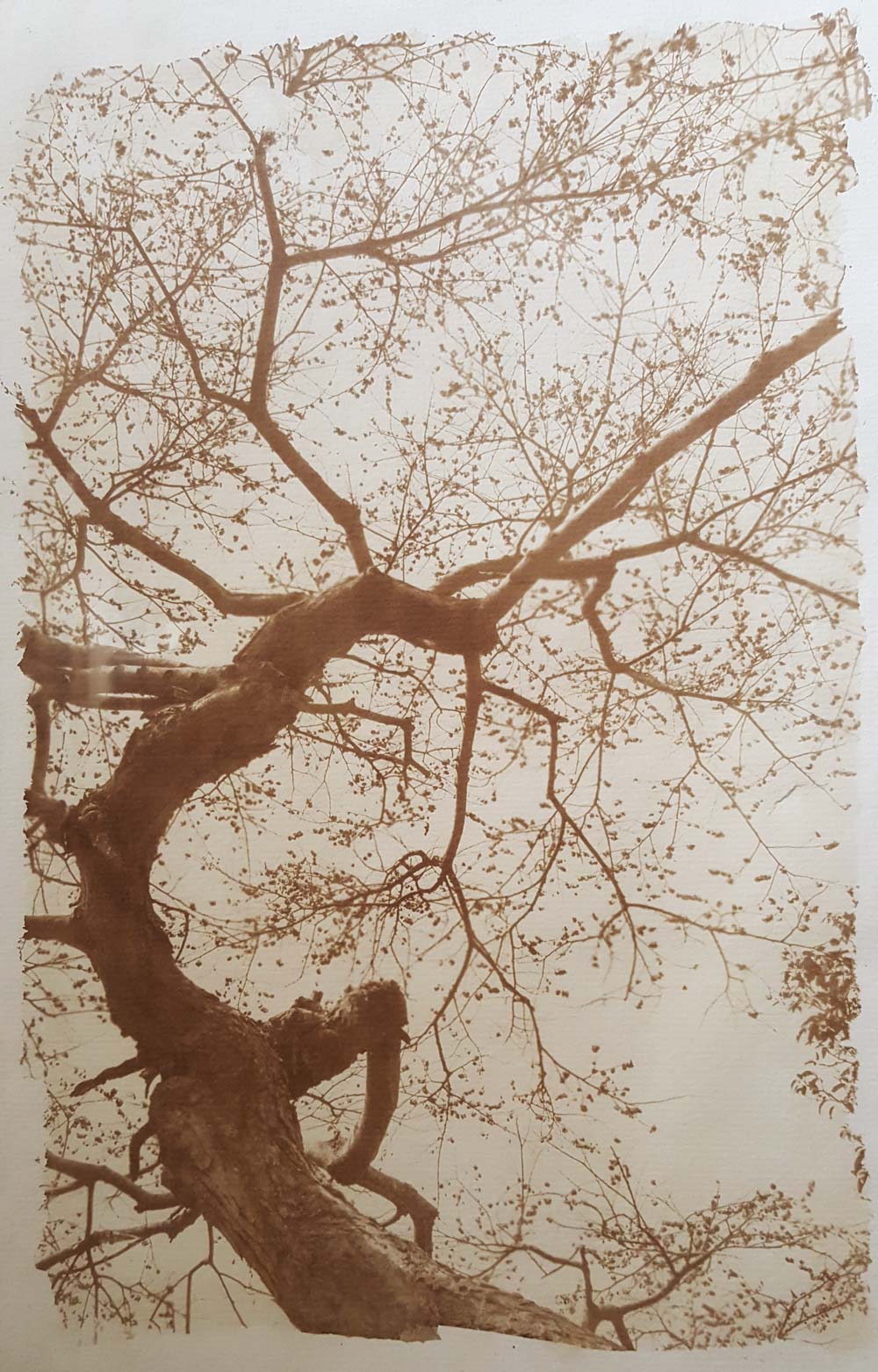
A salt print
in the show Aravalli Deconstructed
Alliance Française de Delhi, down a little lane between India Habitat Centre and
India International Centre, had a varied mix of drawings, paintings, and wax
‘paintings’ of nature and abstract designs. Next I walked a bit farther down the
lane to India International Centre’s Annexe for a look at colored lithographs
Travels of the Prince Waldemar of Prussia to India 1844-46 that illustrate an
adventurous trip across the Indian Himalaya to Tibet, then to a dangerous war
zone near Lahore where the British overpowered the Sikhs.
With time
running short, I hopped on an autorickshaw to Kamani Auditorium for the second
day of the Sangeet Samaroh festival. Pandit Vinayak Torvi and his assistants
gave an energetic Hindustani (northern Indian subcontinent) vocal recital. Next
Smt. Priyadarsini Govind
presented a series of Bharatanatyam dances that told stories of a woman’s
complex love for her man. Although these stories usually come from the Hindu
tradition, such as the love of Radha for the god Krishna, one of the dances
depicted the sorrow of the Bodhisatva’s (Buddha-to-be) wife when he left her and
their baby son at night without saying goodbye. And back at Paharganj, another
vegetarian thali at Café Festa.
8 Nov. New Delhi
The air pollution
has gradually gotten worse during my week here, and today bad enough that schools
closed. It’s a mix of dust, smoke from burning fields, smokestack fumes, and
vehicle emissions. City authorities aren’t up to fixing the problem. That’s a
shame, and perhaps this will be my last visit to New Delhi, at least during
winter when conditions tend to be at their worst.
I made a repeat
visit to the Nikon photography show and the group art exhibition Grains of Canvas at
AIFACS. Joginder Singh, the sculpture artist who displays natural wooden objects, gave me a
tour, explaining many details that I had missed on my previous visit. A few of
the other artists also told of their works. Hindu spiritualism pervades much of
the art. Over near Mandi House at Triveni Kala Sangam, I took in the new
show Scripting Spaces by Ritu Bhutani who expresses her feelings about life.
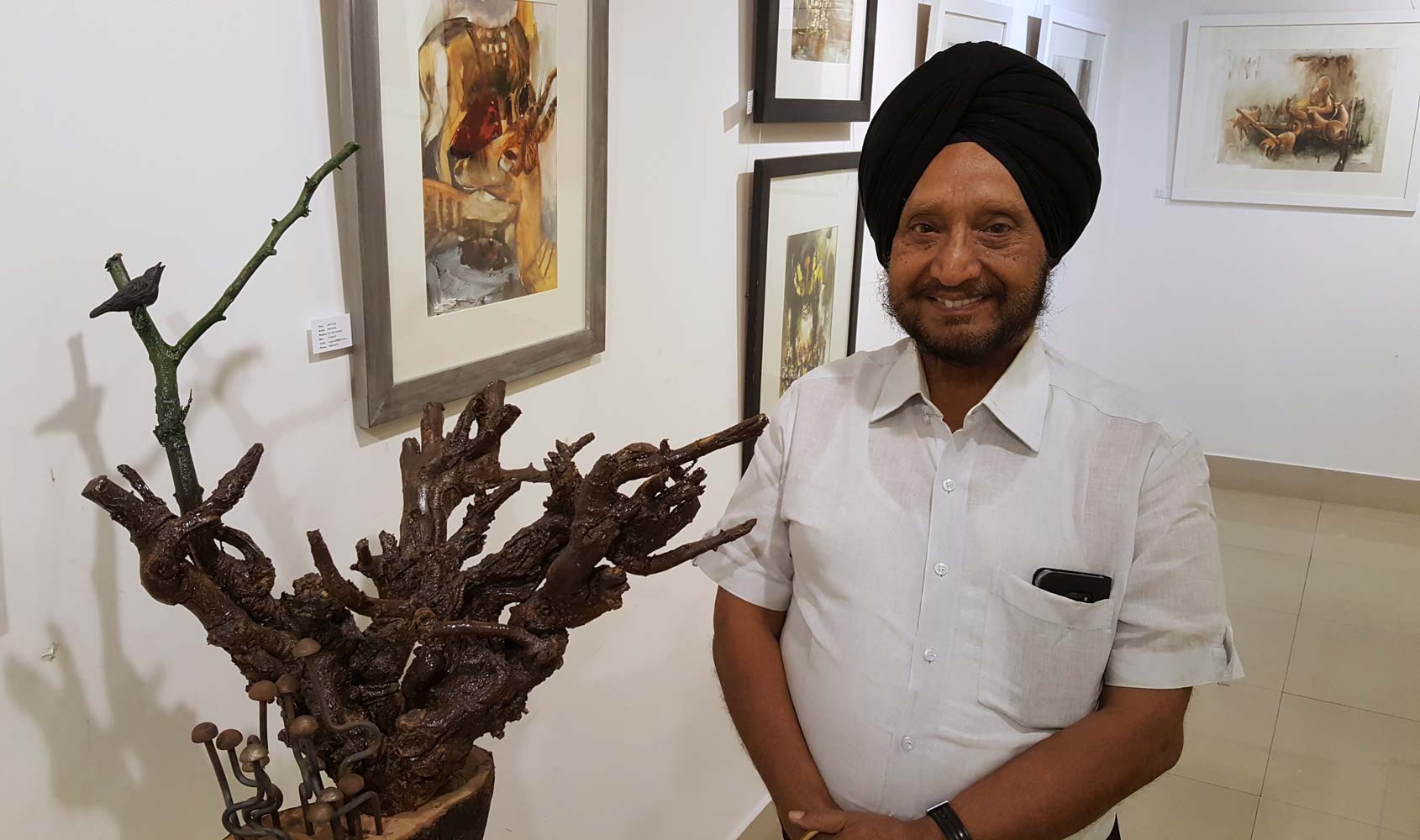
Joginder
Singh with his wood
Struggle and Hope (Grains of Canvas)
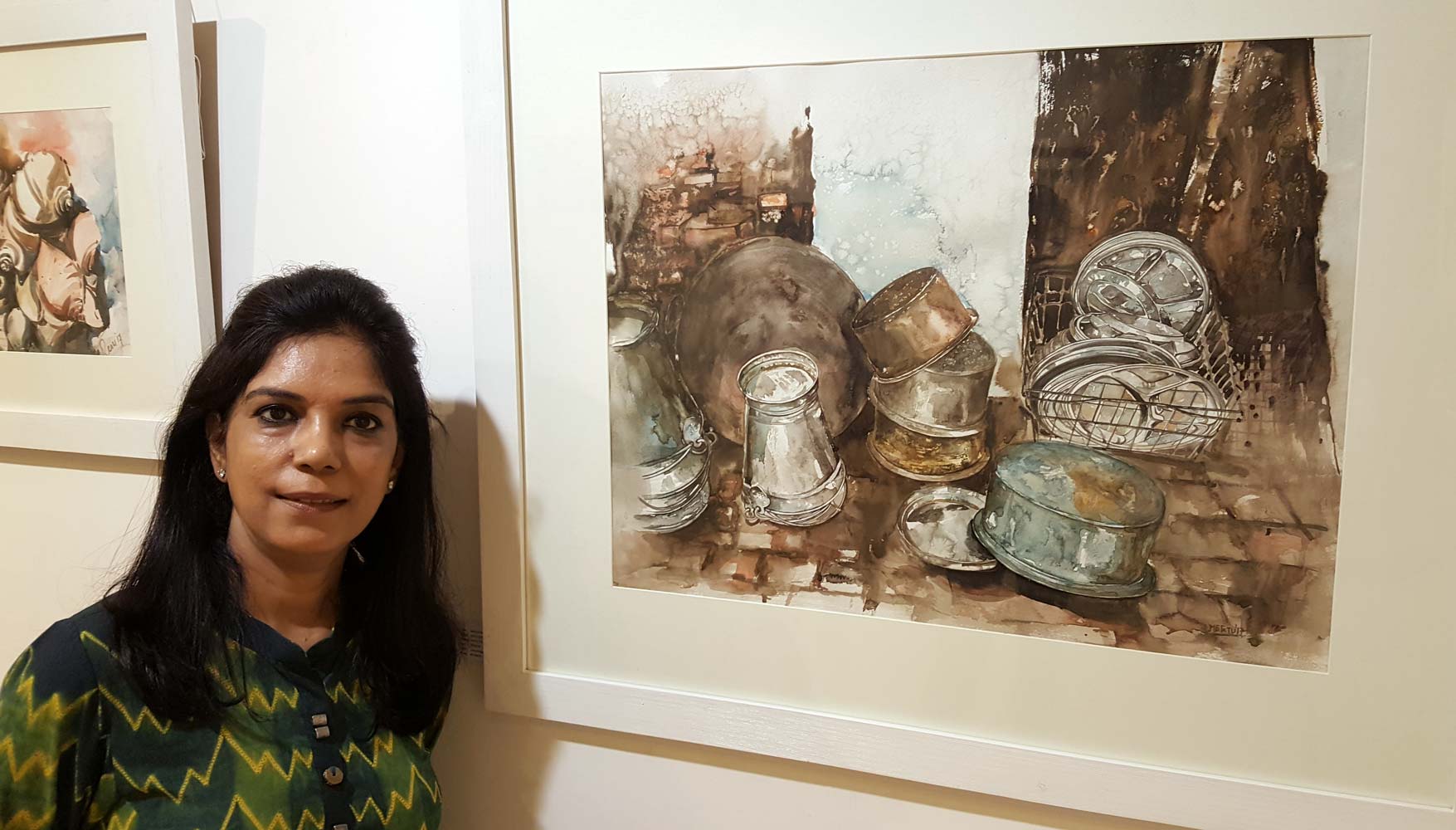
Meetu
Kapoor poses next to her watercolor,
Bartan Vaasan. (Grains of Canvas)
Then I walked north a long block to Bengali Market, a little traffic circle
with restaurants, sweet shops, and other stores. At Nathu’s I ordered up a South
Indian platter with the four best known snacks from that region—an idly, vada,
utapam, and masala dosa—followed by one of my favorite Indian sweets, a kesar
rasmalai. This Bengali treat is like a tiny cake soaked in sweet cream.
The art gallery at Sangeet Natak Akademi had closed to change exhibits, so I
visited the Gallery of Musical Instruments to see the hundreds of types from all over
India, including many played by tribal peoples. There’s also a
collection of Indian masks, some very fierce, in the hallway.
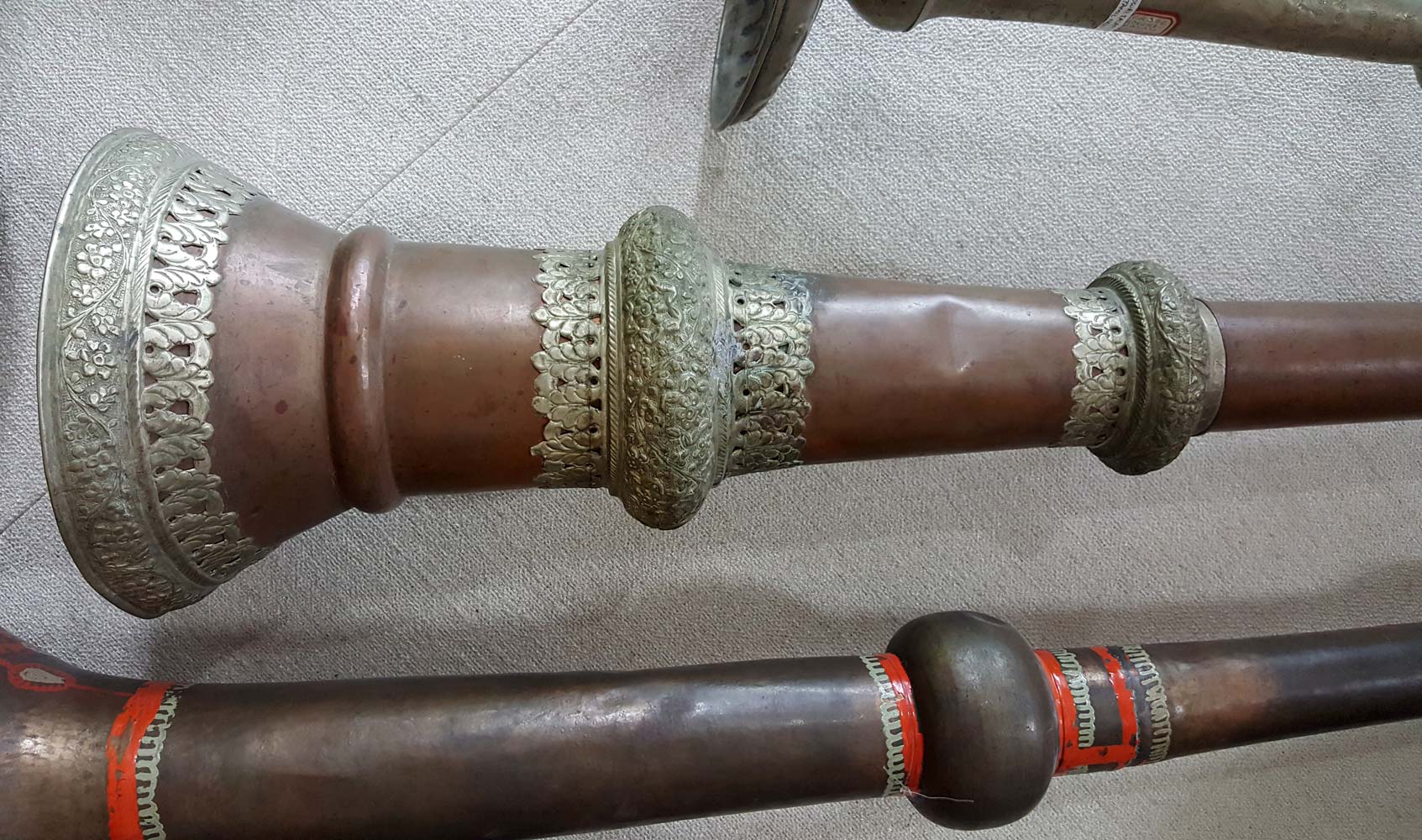
The
Tibetan dungchen, a long trumpet or horn used in Tibetan Buddhist and
Mongolian ceremonies,
is often played in pairs or multiples. The sound has
been compared to the singing of elephants.
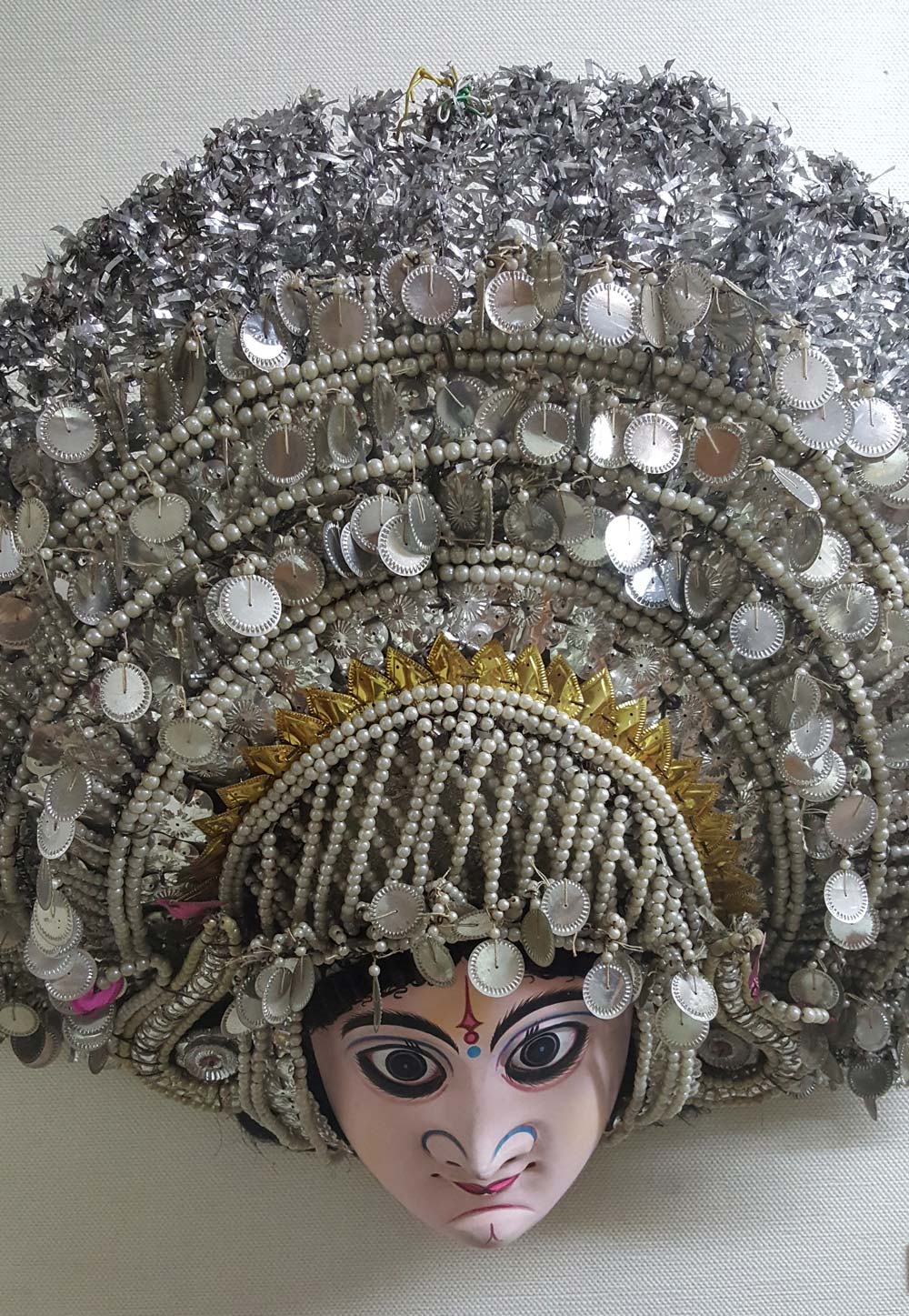
Saraswati
mask from West Bengal
And finally I headed to Kamani Auditorium for the third and final night of Sangeet Samaroh, which began with very lively Kathak dance performances by Smt. Gauri Diwaker. Extremely fast bursts of movement interspersed slower dance movements. Sometimes she stood and moved her feet rapidly up and down to ring the ankle bells. Both she and a male singer would give rapid-fire vocalizations at times. Musicians at the side played pairs of tabla drums, a double-ended drum, and those many, many stringed instruments such as the sarangi that’s played with a bow and the plucked sitar. In the second program sitar player Pandit Nayan Ghosh, with his son on tabla, gave a fine performance.